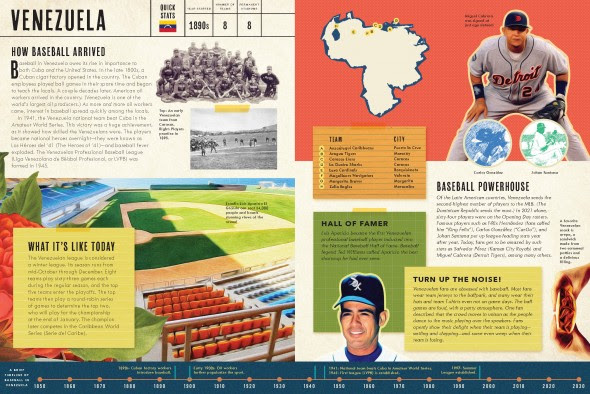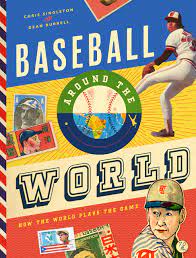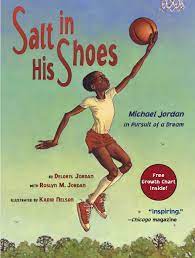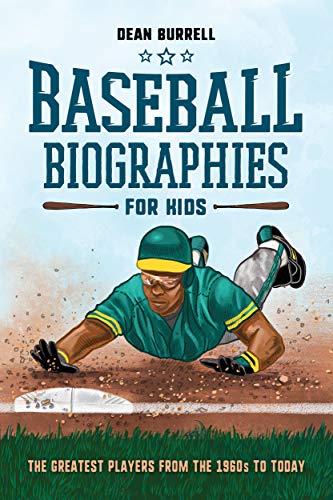There’s nothing more American than baseball, right? Turns out baseball is popular all over the world!
Baseball Around the World is a new, engaging book that tells the history of baseball in 12 different countries. It is a breezy overview of the sport in each nation, with enough deep diving facts to keep young readers interested.

Also, I love the FULL COLOR ILLUSTRATIONS. The book is perfect for those kids who love comic books, but now and then have to pick up a nonfiction title for school. (My child…that’s who I’m talking about…)
I highly recommend it. Content wise, it is appropriate for all ages. The reading level is 7 to 11 year olds, but there is a decent amount of text, so could push that age up. I will say that the timelines at the bottom of each page are slightly confusing, as there are occasionally overlapping markers. So, if your child is new to reading timelines, explain what’s going on there before you set them loose.
I asked the authors, Chris Singleton and Dean Burrell, a few questions about their new book. Read on for some interesting baseball facts, and some book recommendations for reluctant readers who like niche sports nonfiction titles.
This post contains referral links for these products. As an Amazon Associate I earn from qualifying purchases. It does not cost you extra to purchase through my links.

Baseball Around the World by Chris Singleton and Dean Burrell
What was the most surprising fact you learned while researching Baseball Around the World?
Chris: The most surprising fact for me was learning that there are over 200,000 little league teams across the nation.
Dean: Similar to Chris, I was surprised that baseball is played at a professional level in nearly 80 countries.
What about the most interesting fact that you didn’t have space to include?
Chris: I think talking more about the negro leagues would have been something neat to include if there were more space.
Dean: I agree with Chris about the Negro Leagues. I was especially eager to research about how the Black players were welcomed (and celebrated) in the Latin American countries while being segregated in the U.S. I also learned that during WWII, professional baseball asked the president if it should suspend play because of the war. Instead, MLB was encouraged to continue for the sake of the country’s morale. President Roosevelt even supplied the troops with bats and balls, and the All-American Girls Professional Baseball League was formed. Though interesting, these both seemed a tad too political for this book.
As for a fun fact not included, in 2001 the Red Sox bullpen coach planted 18 tomato plants in the Fenway Park bullpen. Boston hadn’t won a championship since 1918, and the coach thought the plants would be a good way to end the “drought.” Nothing like a little superstition to keep fans interested.
How do you decide what information is worthy of including in a nonfiction book?
Dean: I think of baseball (really, all sports) as being for the kids. It’s great to think of that kid playing on a Little League team, dreaming of being an All-Star. There’s an immediate connection–a common language, if you will–that’s shared among everyone who plays.
As for the other information, I think it’s a common dream to visit as many parks as possible. Importantly, it’s not all about just the game on the field–it’s the people, the food and ridiculous mascots. Imagine telling your friends back home that your parents dragged you on some boring vacation but then you took in a game where the fans danced and sang the entire time. Heaven.
Niche nonfiction titles like Baseball Around the World can be great options for reluctant readers. Can you recommend any similar sports books that would also be good options for reluctant readers who enjoyed Baseball Around the World?

Chris: I absolutely loved the book, Salt in His Shoes, by Michael Jordan as a kid.
Dean: Okay, so here’s the story: I was coaxed into writing a book called Baseball Biographies for Kids. (TBH, I did it for fun. As it’s turned out, the book has sold a ton of copies.)

Anyway, what I tried to convey in the book was that famous baseball players are just people like everyone else. They go to coffee shops and grocery stores, and if you see them on the street and say, “hi,” they’ll likely say, “hi,” back. Books like this one are a great way to show kids that celebrities aren’t particularly special or lucky.
Related: Here are more books that I recommend for reluctant readers of both genders.
Snag a free copy of Baseball Around the World!
Thanks so much to Chris and Dean for answering some questions about Baseball Around the World!
The publisher has graciously provided a copy of this book to be given to someone on my email list. If you aren’t on my list and would like to be, sign up HERE. I’ll be drawing a name from my email list to win the book on August 22, 2022.
No purchase necessary. Only eligible for residents of the 50 United States who are 18 years old or older. Void where prohibited. For full contest rules, check out Big Books, Little Ears Sweepstakes Rules page.


